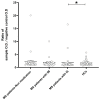Serum Reactive Antibodies against the N-Methyl-D-Aspartate Receptor NR2 Subunit-Could They Act as Potential Biomarkers?
- PMID: 38003360
- PMCID: PMC10671476
- DOI: 10.3390/ijms242216170
Serum Reactive Antibodies against the N-Methyl-D-Aspartate Receptor NR2 Subunit-Could They Act as Potential Biomarkers?
Abstract
Synaptic dysfunction and disrupted communication between neuronal and glial cells play an essential role in the underlying mechanisms of multiple sclerosis (MS). Earlier studies have revealed the importance of glutamate receptors, particularly the N-methyl-D-aspartate (NMDA) receptor, in excitotoxicity, leading to abnormal synaptic transmission and damage of neurons. Our study aimed to determine whether antibodies to the NR2 subunit of NMDAR are detected in MS patients and evaluate the correlation between antibody presence and clinical outcome. Furthermore, our focus extended to examine a possible link between NR2 reactivity and anti-coagulant antibody levels as pro-inflammatory molecules associated with MS. A cross-sectional study was carried out, including 95 patients with MS and 61 age- and gender-matched healthy controls (HCs). The enzyme-linked immunosorbent assay was used to detect anti-NR2 antibodies in serum samples of participants along with IgG antibodies against factor (F)VIIa, thrombin, prothrombin, FXa, and plasmin. According to our results, significantly elevated levels of anti-NR2 antibodies were detected in MS patients compared to HCs (p < 0.05), and this holds true when we compared the Relapsing-Remitting MS course with HCs (p < 0.05). A monotonically increasing correlation was found between NR2 seropositivity and advanced disability (rs = 0.30; p < 0.01), anti-NR2 antibodies and disease worsening (rs = 0.24; p < 0.05), as well as between antibody activity against NR2 and thrombin (rs = 0.33; p < 0.01). The presence of anti-NR2 antibodies in MS patients was less associated with anti-plasmin IgG antibodies [OR:0.96 (95%CI: 0.92-0.99); p < 0.05]; however, such an association was not demonstrated when analyzing only RRMS patients. In view of our findings, NR2-reactive antibodies may play, paving the way for further research into their potential as biomarkers and therapeutic targets in MS.
Keywords: N-methyl-D-aspartate (NMDA) receptor; anti-coagulant serine proteases; antibodies; excitotoxicity; multiple sclerosis.
Conflict of interest statement
The authors declare no conflict of interest.
Figures





Similar articles
-
Antibodies to blood coagulation components are implicated in patients with multiple sclerosis.Mult Scler Relat Disord. 2022 Jun;62:103775. doi: 10.1016/j.msard.2022.103775. Epub 2022 Mar 31. Mult Scler Relat Disord. 2022. PMID: 35417817
-
Fatigue in SLE: diagnostic and pathogenic impact of anti-N-methyl-D-aspartate receptor (NMDAR) autoantibodies.Ann Rheum Dis. 2019 Sep;78(9):1226-1234. doi: 10.1136/annrheumdis-2019-215098. Epub 2019 Jun 11. Ann Rheum Dis. 2019. PMID: 31186256
-
Clinical significance of anti-DNA/N-methyl-D-aspartate receptor 2 antibodies in de novo and post-steroid cases with neuropsychiatric systemic lupus erythematosus.Int J Rheum Dis. 2019 Mar;22(3):443-448. doi: 10.1111/1756-185X.13392. Epub 2018 Oct 24. Int J Rheum Dis. 2019. PMID: 30358102
-
Systemic lupus erythematosus, the brain, and anti-NR2 antibodies.J Neurol. 2012 Apr;259(4):622-9. doi: 10.1007/s00415-011-6232-5. Epub 2011 Sep 10. J Neurol. 2012. PMID: 21909801 Review.
-
Glutamate receptor antibodies in neurological diseases: anti-AMPA-GluR3 antibodies, anti-NMDA-NR1 antibodies, anti-NMDA-NR2A/B antibodies, anti-mGluR1 antibodies or anti-mGluR5 antibodies are present in subpopulations of patients with either: epilepsy, encephalitis, cerebellar ataxia, systemic lupus erythematosus (SLE) and neuropsychiatric SLE, Sjogren's syndrome, schizophrenia, mania or stroke. These autoimmune anti-glutamate receptor antibodies can bind neurons in few brain regions, activate glutamate receptors, decrease glutamate receptor's expression, impair glutamate-induced signaling and function, activate blood brain barrier endothelial cells, kill neurons, damage the brain, induce behavioral/psychiatric/cognitive abnormalities and ataxia in animal models, and can be removed or silenced in some patients by immunotherapy.J Neural Transm (Vienna). 2014 Aug;121(8):1029-75. doi: 10.1007/s00702-014-1193-3. Epub 2014 Aug 1. J Neural Transm (Vienna). 2014. PMID: 25081016 Review.
References
MeSH terms
Substances
Grants and funding
LinkOut - more resources
Full Text Sources

